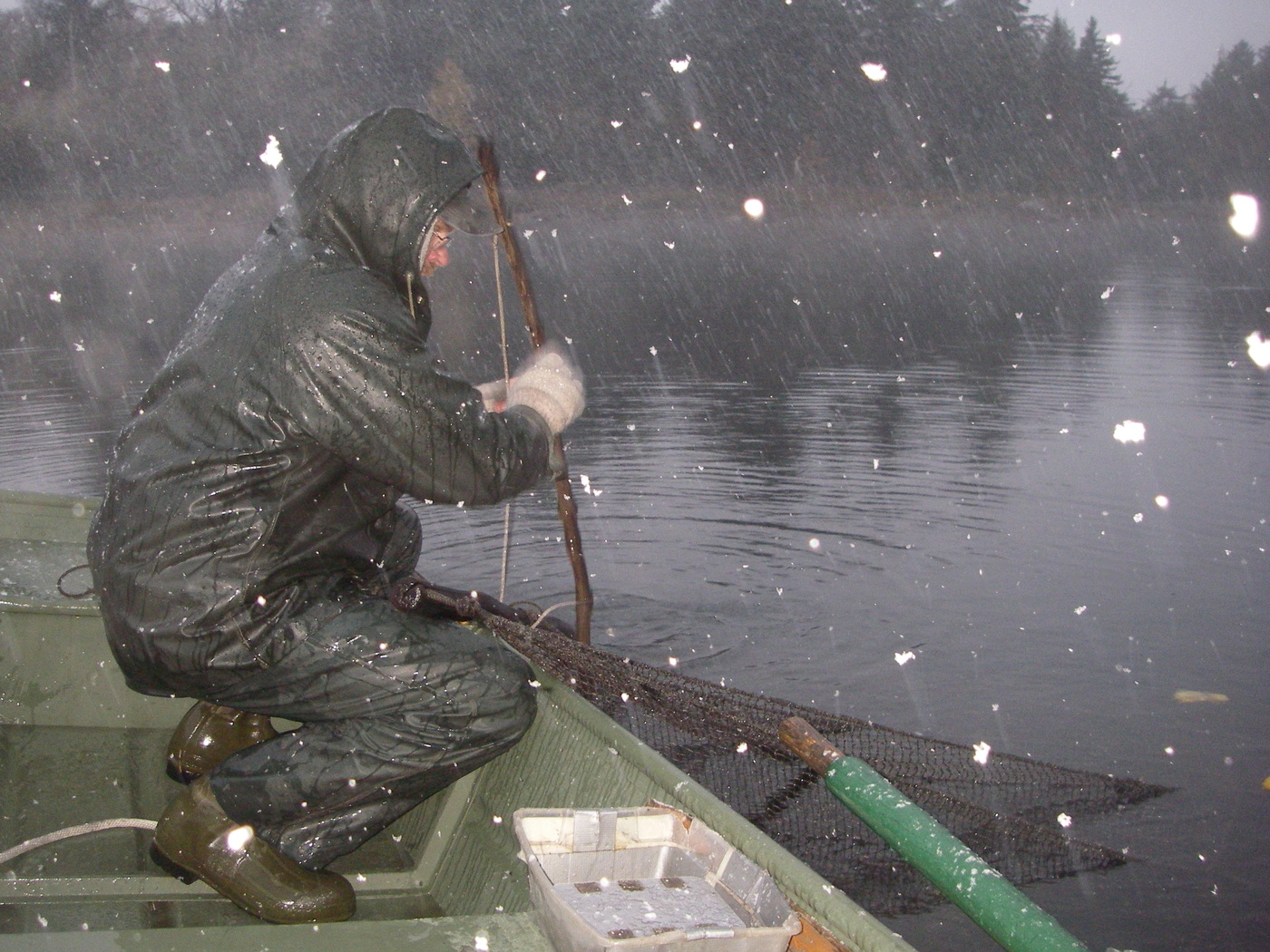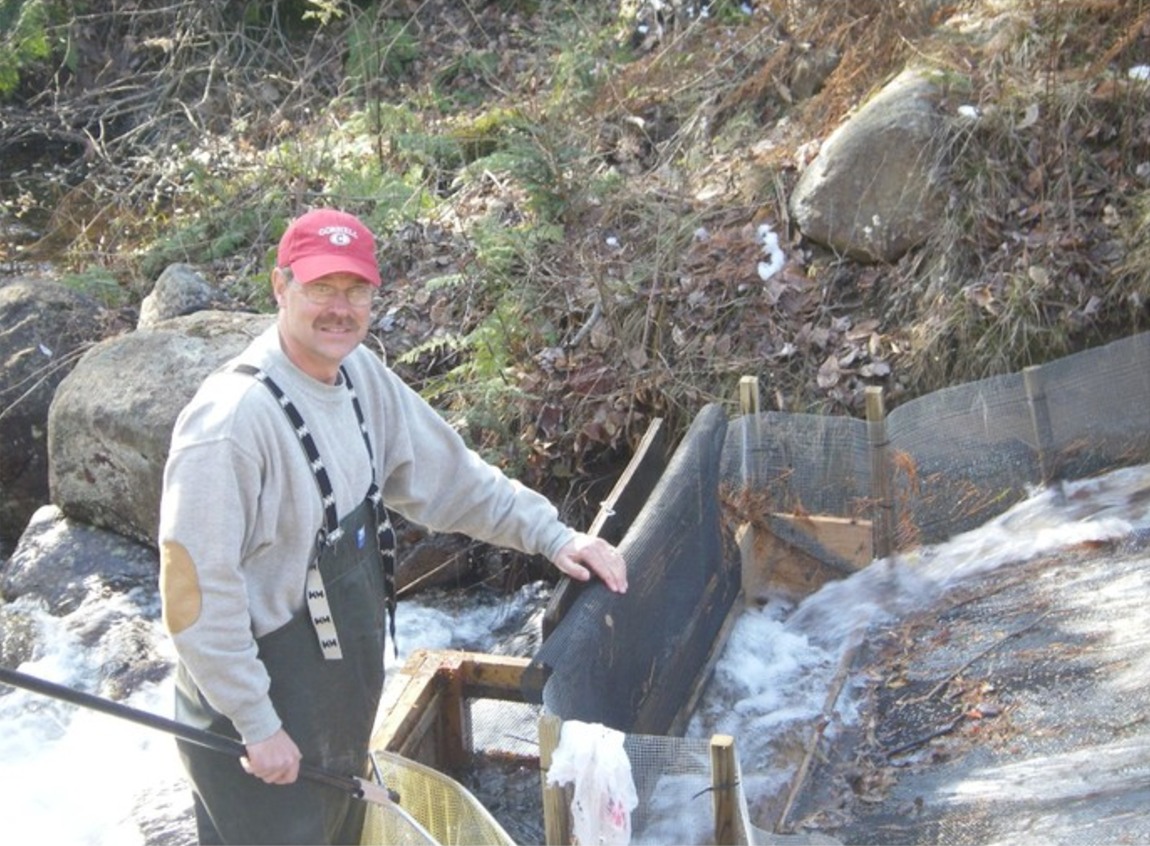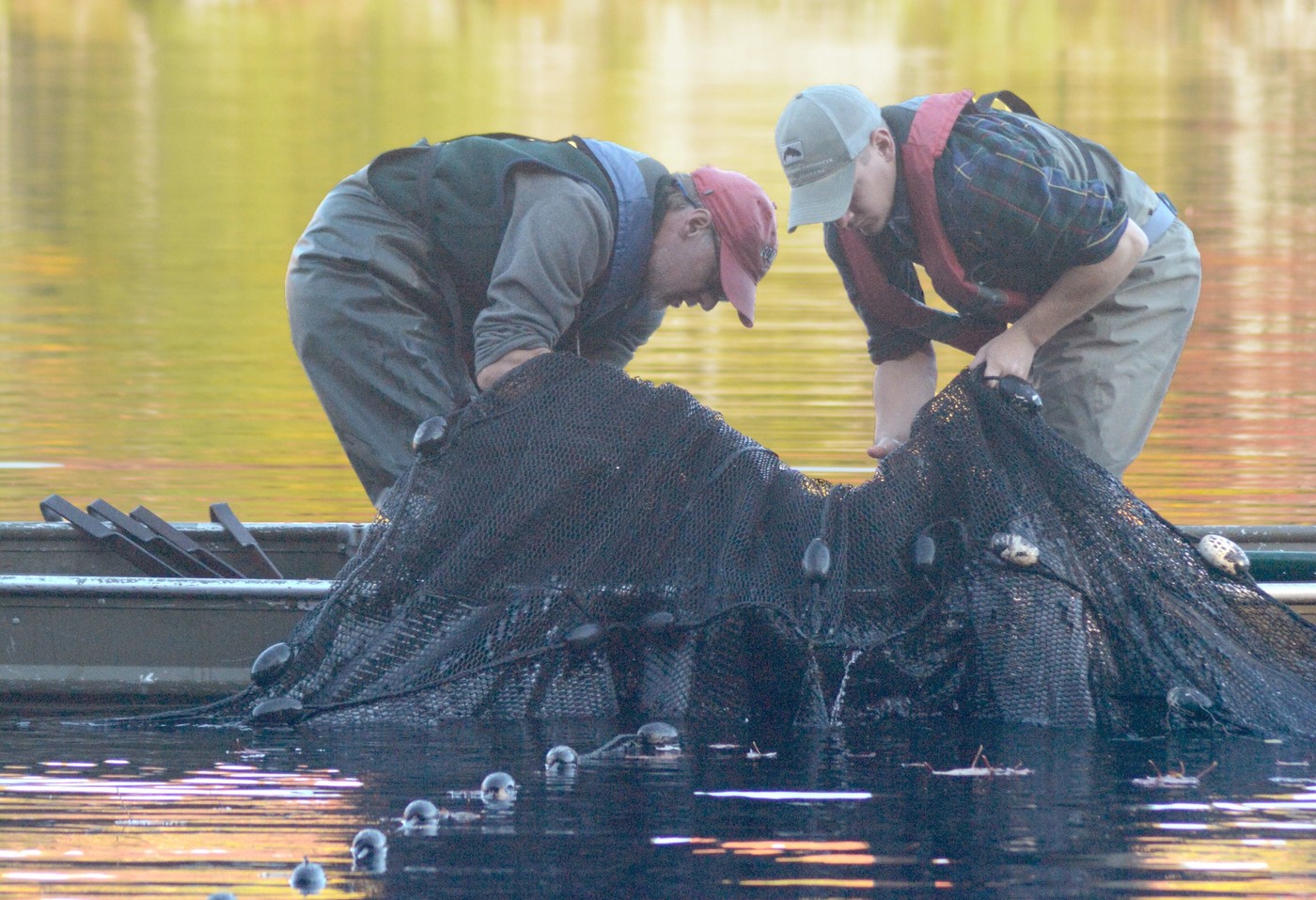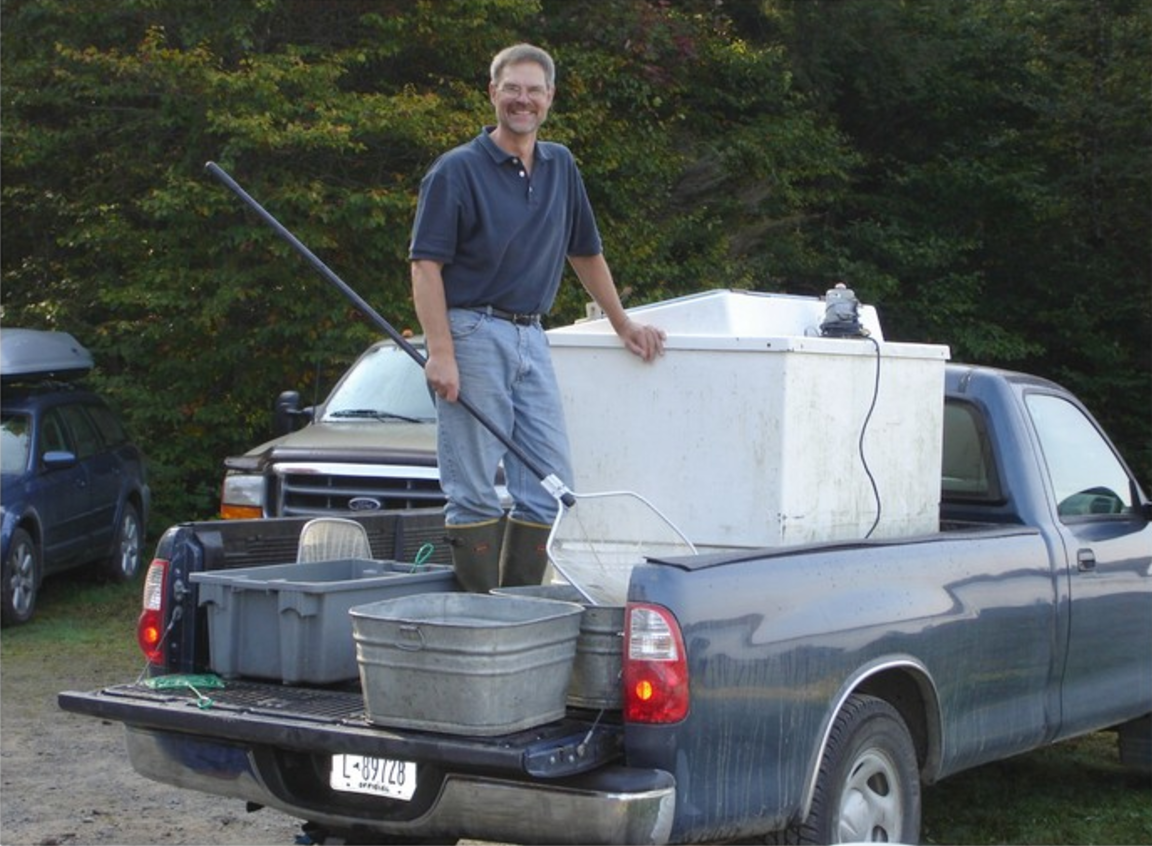Stewardship
Private Stewardship produces public benefits
One of the great Adirondack success stories involving a private sector partnership with an educational institution is the work done by Cornell University on the lands and waters of the Adirondack League Club, along with a number of other private lands within the Adirondack Park. North Country Public Radio has a great piece on the work of fisheries biologist Dan Josephson and the Adirondack Fishery Research Program.
ALA Presents 2017 Stewardship Award
The highlight of the annual fall meeting, held at the Adirondack League Club, was the presentation of our 2017 ALA Stewardship Award to Dr. Ross Whaley. Ross has been part of the Adirondack scene for many years and his contribution to our membership has been significant. He has served as Chairman of the Adirondack Park Agency and was instrumental in creating the Common Ground Alliance. In addition to the normal framed tribute the ALA presented Ross with a custom made fly rod provided by the JP Ross Co. Given his love of trout fishing it will most likely get lots of use. There were also letters of recognition from Governor Cuomo, Senator Betty Little, Assemblyman Dan Stec and a host of others. There was little doubt as to the respect and admiration the Adirondack community has for Ross…we couldn’t agree more.
ALA Presents 2016 Stewardship Award
The highlight of our annual winter meeting, held at the Adirondack League Club, was the presentation of our 2016 ALA Stewardship Award to the Adirondack Lakes Alliance. While this organization is relatively new to the Adirondack scene they have done great work in a short period of time and we were proud to recognize their efforts. The threats to our environment and economy from aquatic invasive species, has been the focus of the Adirondack Lakes Alliance since they began. They have helped to organize a wide range of lake and river associations throughout the Adirondack Park, along with local government, state agencies, residents and key stakeholders to help create awareness for this important issue.
They were represented during the award presentation by Ed Griesmer and Jane Smith. Are hats are off to the “other ALA” and we wish them continued success in the great leadership they provide.
Adirondack Lakes Alliance Executive Director, Ed Griesmer offered this statement: “The Adirondack Lakes Alliance is pleased and honored to receive the ALA Stewardship Award. In accepting this award, we do so, on behalf of the many lake and river associations throughout the Adirondack region and their thousands of volunteers who serve as first responders in addressing issues affecting our waterways. This award helps to give recognition to the important role they play in keeping our waters clean and safe for all to use and enjoy.”
Senator Betty Little presents Jane Smith and Ed Griesmer with the 2016 Stewardship Award.
ALA Recognizes Outstanding Stewardship
In May of 1996, the Adirondack Landowners Association joined with the Adirondack Nature Conservancy/Adirondack Land Trust to sponsor a Stewardship Award recognizing sound conservation and management of private lands within the Adirondack Park. In 2006, the ALA assumed the role of sole sponsor of this award.
Though originally the award was conceived as an annual award honoring a landowner who demonstrated a commitment to good stewardship of their property, the ALA board decided to widen the scope of the award to include other organizations who have demonstrated their support of the ideal of stewardship. The award is now given periodically when a sufficiently notable candidate is available. Members of ALA are strongly encouraged to make nominations to ALA’s President or the Stewardship Committee.
Fourteen awards have been presented since the first, which went to the North Woods Club. The most recent recipient, in 2014, was NYS Senator Betty Little. Others who have received the Stewardship Award include: The Otetiana Council of Boy Scouts/The Adirondack League Club (1997), Finch & Pruyn (1998), Erwin and Polly Fullerton (2000), Town of Westport (2001), Highland Forest, LLC (2002), Paul Smith’s College (2003,) Bill Polihronakis, P&T Timber Sales (2004), Timothy L. Barnett, Adirondack Nature Conservancy/Adirondack Land Trust (2006), Peter R. Stein, The Lyme Timber Company (2007), Cornell Fisheries Program (2012) Common Ground Alliance (2013)
ALA Invasive Species Education Program
An educational display in Lewis County.
The ALA initiated a three part education program to help reduce the spread of aquatic invasive species. Working in collaboration with the Department of Environmental Conservation and the Department of Motor Vehicles we were instrumental in creating an educational insert to be included in all mailed renewals for boat and trailer registrations. This new program began in the spring of 2013.
In addition, local DMV offices, operated by the County Clerks throughout upstate New York have partnered with ALA to help with the education effort. The County Clerks agreed to provide space for signage and educational brochures on aquatic invasive species. The ALA supplied the signage and brochures to the approximately 30 County Clerks. The County Clerks are deserving of high praise for their enthusiasm and the way they have embraced ALA’s request to assist in its invasive species education program.
Going forward we hope to continue this educational effort about the serious problem of aquatic invasive species with the cooperation of private sector businesses and local government. The ALA plans to work with North Country business owners and town government officials to have posters and handouts about preventing the spread of invasive species displayed throughout the Adirondacks.
Free Adirondack Boat Wash Stations - Visit adkcleanboats.com for details
The ALA was an early leader in recognizing the threat of aquatic invasive species (AIS), launching an education campaign in 2013 that involved including information on AIS in all mailed renewals for boat and trailer registrations, and providing county clerks with signage and educational brochures.
Since then, numerous organizations and New York State have stepped up in a very major way to help stop the spread of AIS. Perhaps the most helpful and concrete measure in the Adirondacks has been the establishment of boat washing and decontamination stations throughout the Adirondacks during boating season, administered by the Adirondack Watershed Institute under a 5 year, $9.3 million contact. In the 2017 season, aquatic invasive species were intercepted 3,849 times!
Please, if you're transporting a boat to or between Adirondack waters, plan on stopping at one of these stations.
Progress is being made in the effort to control the Hemlock Woolly Adelgid before it reaches the Adirondacks
Extent of HWA as of 2012.
In May 2016, Mark Whitmore, an Extension Associate at Cornell University gave a presentation to the Adirondack Landowners Association on hemlocks in the Adirondacks, and the threat the Hemlock Woolly Adelgid (HWA) is to them. New York State has more hemlocks than any other state, and they are particularly abundant in the southern and eastern portion of the Adirondacks. Unfortunately the Hemlock Woolly Adelgid, which was discovered on the east coast in the 1950s and has devastated hemlocks from Georgia to New England, is steadily creeping towards the Adirondacks. It has been discovered as close as Schenectady, just south of the Adirondacks.
Cold winters have protected the Adirondacks from the HWA, but a combination of warmer winters and cold adaptability mean that it is likely that Adirondack hemlocks will begin to be affected unless action is taken.
Mr. Whitmore’s presentation focused on not only the threat to hemlocks, but also how they can be saved. HWA actually appeared on the west coast in the 1920s, yet has not devastated western hemlock species thanks to a number of native insect species that keep HWA populations in check. Of particular importance are a small beetle, Laricobius nigrinus, and two species of silver flies Leucopis piniperda and Leucopis argenticollis. Although they don’t eliminate HWA altogether, these insects keep populations low enough that hemlocks can survive.
Mr. Whitmore has been capturing the predator insects in the Pacific Northwest, and releasing them on hemlocks infested with HWA in central New York. He’s been focusing on hemlock hedges infested with HWA, as they are easier to monitor than trees, and it is possible to collect some of the predator insects to release elsewhere. However, capturing tiny insects in the wild to release elsewhere is a technique that would be very difficult to scale up.
In the audience at the May 2016 Adirondack Landowners Association meeting was Karen Feldman, who serves on the Adirondack Park Agency board. She prepared a memorandum on Mr. Whitmore’s presentation on HWA and sent it to a few of the APA board members. Ms. Feldman also spoke about Mr. Whitmore’s presentation during the public comments portion of the meeting.
Karyn Richards, who is the head of state lands for DEC, attended the June APA meeting as the DEC designee. She agreed that NYS needed to move forward with a plan, so she spoke with, among others, Rob Davies, who is DEC’s Director of Lands and Forests. Ms. Richards and Mr. Davies called Ms. Feldman the next week and offered to help. Since then, DEC has taken the lead by agreeing to fund the setup of a lab to rear the HWA predators. Cornell University is contributing the facilities. The money has not yet been released to Cornell but it is hoped it will be in the next few months.
The Catskills are currently the frontline of the HWA infestation in NYS, and the first place lab-reared HWA predators will be released. If HWA is brought under control in the Catskills, the threat to Adirondack hemlocks will likely be averted.
The Adirondack Landowners Association is encouraged to see this progress towards saving New York’s hemlocks.
You can read more about the effort here:
"Hemlock Woolly Adelgid Coordinated Commitment to Improved Management and Restoration of Hemlock: 2014-2018" USDA Forest Service. April 2013. https://www.na.fs.fed.us/fhp/hwa/pubs/other_info/2014-18%20HWA%20National%20Initiative%20Strategic%20Plan_FINAL.pdf
Friedlander, Blaine. “Cornell introduced silver flies to save hemlock forests.” Cornell Chronicle. June 26, 2015. http://www.news.cornell.edu/stories/2015/06/cornell-introduces-silver-flies-save-hemlock-forests
Gilson, Roger Hannigan. “Fighting pest with pest to save endangered hemlock.” Columbia-Greene Media. January 25, 2017. http://www.registerstar.com/news/article_33603304-e2ba-11e6-90a6-db927e996771.html
Zilahi-Balogh, Gabriella MG, L. T. Kok, and Scott M. Salom. "A predator case history: Laricobius nigrinus, a derodontid beetle introduced against the hemlock woolly adelgid." Proceedings, 2nd International Symposium of Biological Control of Arthropods. 2005. https://www.bugwood.org/arthropod2005/vol2/13c.pdf
Adirondack Lakes Alliance Symposium
The Adirondack Landowners Association joined with a number of other organizations to be part of the Adirondack Lakes Alliance 2016 Symposium held at Paul Smith's College. This well attended event offered valuable information on helping to protect both the lands and waters of the Adirondacks from the impact of invasive species and water pollution. There were presentations on water quality, terrestrial invasives, road salt and more...additionally participants were encouraged to visit the Resource Fair to learn more about what is being done to educate the public on a wide range of invasive and environmental threats.
We were pleased to be a part of this great program and look forward to working with the stakeholders and organizations to help with these important efforts.
Learn About the Hemlock Woolly Adelgid
At the Spring 2016 meeting, Mark Whitmore of Cornell gave a presentation on the Hemlock Woolly Adelgid, its inevitable arrival in the Adirondacks, and what can be done about it. Watch the informative video below to learn more about the threat.
NYS Support for Forest Management
Perhaps the most significant way landowners can help protect the wild character of the Adirondacks is by simply keeping properties in one piece. Forest management helps keep large forested tracts affordable and intact. New York State provides substantial support for forest owners, which you can read about in the Private Forest Management section of the NYS DEC site.
Click above to read about the important contributions Adirondack landowners are making to the understanding and protection of New York's natural resources.
ALA Members Partner with DEC on Pine Marten Study
One of the presentations at our recent spring meeting was made by Don Roark, President of the Miller Park Association. Miller Park is one of the founding members of the ALA and a great advocate of scientific wildlife management and sound conservation and stewardship efforts. Don’s presentation focused on the results of a multi-year public/private partnership with various Adirondack Landowners and the NYS DEC. Many of the landowners involved were ALA members including: Adirondack League Club, Ausable Club, Elk Lake, Finch Paper, LLC, Miller Park Association, North Woods Club, Wilmurt Club and West Canada Preserve.
This type of program underscores the real value and the stewardship role that private landowners play in the Adirondacks. The DEC has recognized that this research would not be possible without the help and cooperation of the private sector. It serves as another example of the important contribution our members make to all of the Adirondacks.















